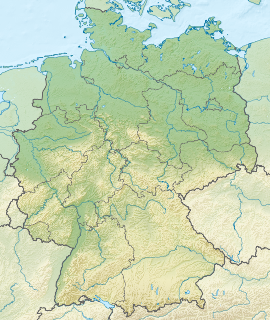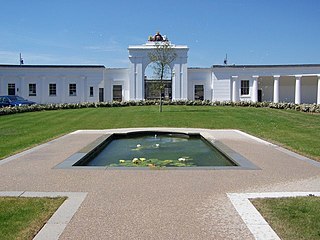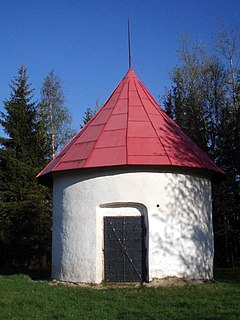
A Bergmagazin is a building that served as a granary for miners and the population of mining towns in German-speaking Europe.

A Bergmagazin is a building that served as a granary for miners and the population of mining towns in German-speaking Europe.
The construction of Bergmagazins in the Electorate and Kingdom of Saxony grew rapidly from 1806 at the suggestion of senior mining official (Oberberghauptmann), Friedrich Wilhelm Heinrich von Trebra. As a result of the great famines in the upper Ore Mountains at the end of the 18th century caused by several poor harvests, Trebra recommended the construction of multi-storey, stone Bermagazin buildings where grain could be deposited after harvesting and stored for several months or even years.

A barn is an agricultural building usually on farms and used for various purposes. In the North American area, a barn refers to structures that house livestock, including cattle and horses, as well as equipment and fodder, and often grain. As a result, the term barn is often qualified e.g. tobacco barn, dairy barn, sheep barn, potato barn. In the British Isles, the term barn is restricted mainly to storage structures for unthreshed cereals and fodder, the terms byre or shippon being applied to cow shelters, whereas horses are kept in buildings known as stables. In mainland Europe, however, barns were often part of integrated structures known as byre-dwellings. In addition, barns may be used for equipment storage, as a covered workplace, and for activities such as threshing.

The Harz[haːɐ̯ts] is a Mittelgebirge that has the highest elevations in Northern Germany and its rugged terrain extends across parts of Lower Saxony, Saxony-Anhalt, and Thuringia. The name Harz derives from the Middle High German word Hardt or Hart, Latinized as Hercynia. The Brocken is the highest summit in the Harz with an elevation of 1,141.1 metres (3,744 ft) above sea level. The Wurmberg is the highest peak located entirely within the state of Lower Saxony.

The Rammelsberg is a mountain, 635 metres (2,083 ft) high, on the northern edge of the Harz range, south of the historic town of Goslar in the North German state of Lower Saxony. The mountain is the location of an important silver, copper, and lead mine, the only mine which had been working continuously for over 1,000 years when it finally closed in 1988. Since 1992, the visitor mine of Rammelsberg has become a UNESCO World heritage site.

Freiberg is a university and former mining town in the Free State of Saxony, Germany. It is a so-called Große Kreisstadt and the administrative centre of Mittelsachsen district.

Ostróda is a town in northern Poland, in Masuria, seat of the Ostróda County in the Warmian-Masurian Voivodeship, with 33,191 inhabitants as of December 31, 2009.

Osterode am Harz often simply called Osterode, is a town in south-eastern Niedersachsen on the south-western edge of the Harz mountains. It was the seat of government of the district of Osterode. Osterode is located on the German Timber-Frame Road.

A granary is a storehouse or room in a barn for threshed grain or animal feed. Ancient or primitive granaries are most often made out of pottery. Granaries are often built above the ground to keep the stored food away from mice and other animals.

Herzberg am Harz is a town in the Göttingen district of Lower Saxony, Germany.

Marienberg is a town in Germany. It was the district capital of the Mittlerer Erzgebirgskreis in the southern part of Saxony, and since August 2008 it has been part of the new district of Erzgebirgskreis. As of 2007, the town had 14,181 inhabitants.

Sankt Andreasberg is a former town in the district of Goslar, in Lower Saxony, Germany. Since 1 November 2011, it is part of the town Braunlage. It is situated in the Harz, approximately 7 km west of Braunlage proper, and 20 km east of Osterode am Harz.

Johanngeorgenstadt is a mining town in Saxony’s Ore Mountains, 17 km south of Aue, and 27 km northwest of Karlovy Vary. It lies in the district of Erzgebirgskreis, on the border with the Czech Republic, is a state-recognized health resort (Erholungsort), and calls itself Stadt des Schwibbogens. Its population decline since the 1950s has been extremely severe falling from 45,000 residents in 1953 to only about one tenth of that now.
The South Harz Railway is a railway line through the German states of Lower Saxony and Thuringia. It runs from Northeim to Nordhausen, via Herzberg am Harz, Bad Lauterberg-Barbis, Bad Sachsa, Walkenried and Ellrich. The line is 69 kilometres (43 mi) long.

The Hanskühnenburg is a mountain hut in the Harz mountains. It is located at a height of 811 m (2,661 ft) above sea level in fields known as Auf dem Acker, or simply Acker, in the middle of the Harz National Park and has its own observation tower. Its name comes from the legendary Hanskühnenburg Crag 300 metres to the northwest, which was visited on 14 August 1784 by Johann Wolfgang von Goethe. Opposite the tower are the Hanskühnenburg Rocks that are relatively small by comparison with the Klippe. A bronze plaque was mounted on these rocks in 1999 to commemorate Goethe's visit. In front of the Hanskühnenburg Rocks, a monument was erected in 1924 to Albert Leo Schlageter. It has since fallen over and is rather weathered.

The Herzberg–Seesen railway, also known as the West Harz Line, is a 32 km long railway line, that runs along the western edge of the Harz mountains and serves the town and the district of Osterode am Harz. It is the shortest link from Brunswick to Erfurt and is worked today by Lint multiples from Brunswick via Salzgitter, Seesen and Osterode to Herzberg mainly at hourly intervals. In Herzberg there are connexions to Göttingen and Nordhausen.

The Upper Harz Water Regale is a system of dams, reservoirs, ditches and other structures, much of which was built from the 16th to 19th centuries to divert and store the water that drove the water wheels of the mines in the Upper Harz region of Germany. The term regale, here, refers to the granting of royal privileges or rights in this case to permit the use of water for mining operations in the Harz mountains of Germany.
The Zwickau–Schwarzenberg railway is a main line railway in the German state of Saxony. It extends from Zwickau through the valleys of the Zwickauer Mulde and the Schwarzwasser via Bad Schlema and Aue to Schwarzenberg. It opened in 1858 and it is one of the oldest railways in Germany. It is now served by Regionalbahn trains, operated by Erzgebirgsbahn between Zwickau and Johanngeorgenstadt.

Freudenstein Castle is located on the Schloßplatz on the edge of the town centre of Freiberg in the German state of Saxony. Its history is closely linked to the House of Wettin. After several conversions the castle is now a stately home with four wings comprising these buildings: the Langes Haus, Neues Haus, Kirchenflügel, Großer Turm und Schmales Haus.

The Kalte Birke is a cross tracks in the Harz Mountains of Germany where there is a refuge hut and former settlement. It is located west of the Innerste Reservoir at about 540 metres above sea level. It lies in the unparished area of Harz in the county of Goslar. Historically it is closely linked to the municipality of Hahausen and village of Neuekrug, four kilometres northwest.

Royal Clarence Yard in Gosport, Hampshire, England was established in 1828 as one of the Royal Navy's two principal, purpose built, provincial victualling establishments. It was designed by George Ledwell Taylor, Civil Architect to the Navy Board and named after the then Duke of Clarence. The new victualling yard was developed on approximately 20 hectares of land, some of which was already in use as a brewing establishment at Weevil on the west shore of Portsmouth Harbour, to the north of Gosport.

The Pulverturm in Johanngeorgenstadt was a tower used by the mining authorities for storing gunpowder for the Neu Leipziger Glück pit. It was built in 1798 in a sparsely settled region outside the town on the spoil heap of the Gotthelf Schaller pit on Eibenstocker Straße by the Neu Leipziger Glück Union. In 1828 it was sold for 105 Reichstaler as a mining area powder tower. The purchase price was advanced by the Royal Stolln, who also took over its repair. For every hundredweight of powder stored, the mines were then charged a taler towards the repayment of the advance. In 1864, the powder tower was sold to the district council for 50 thalers.